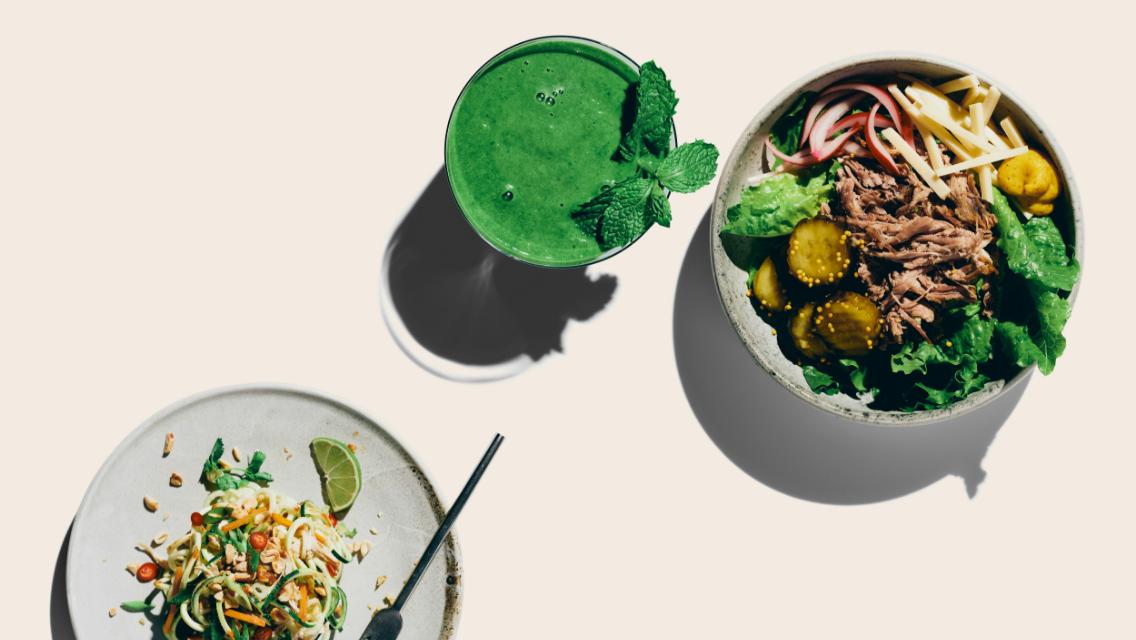“Can I just copy your eating plan? Can I pay you to double what you cook and then I will eat that?”
If I had a dime for every time I had a client who asked me these questions, I’d be wealthy. And from talking to my dietitian peers, it sounds like a common request from those who they are coaching as well.
While the sentiment is understandable, following exactly what someone else is doing — even if they’re a nutrition expert — does not automatically make their plan the right plan for you.
We all have different goals, body compositions, metabolic needs, and preferences. The right approach truly varies from person to person.
Foundational Nutrition Priorities
That being said, there are some foundational habits that apply to most people to see optimal health and results. From my experience, specialized strategies and customizations based on your metabolism will work best when these eight cornerstones are already in place:
- Higher-protein approach, targeting one gram of protein per pound of ideal body weight.
- Adequate hydration, ideally consuming an ounce of water for every two pounds you weigh.
- Plenty of produce, with half of each plate filled with colorful, non-starchy vegetables.
- Inclusion of healthy fats, from unprocessed forms at most meals.
- Strategic carbohydrate choices, adjusted to activity level and prioritized around whole-food options such as beans, lentils, and fruit over processed ones whenever possible.
- Limitation of alcohol and added sugar.
- High-quality supplementation that includes core nutrients to fill in the gaps.
- Flexibility from an 80/20 approach, with at least 80 percent of choices on-plan with 20 percent allowance for wiggle room, celebrations, or unplanned options.
These tenants may sound simple (they are), but that doesn’t mean they’re easy (they aren’t).
To personally position themselves for nutrition success, below are the three habits that Life Time dietitians swear by. They’re not only doable, but they set up the right framework to help make the application of the eight priorities above more convenient and likely to happen.
Habit No. 1: Daily Shake
Protein shakes are not just for body builders who want to bulk up. When done right, they’re a perfect go-to to set a healthy tone to the day.
At Life Time, we recommend a real-food-first approach. But we also recognize that in today’s society, convenience and time-saving strategies when it comes to eating are a priority. You can easily see this by observing the lines in the drive-throughs of fast-food restaurants around lunch hour every day or by checking the recent order history in your favorite food delivery app.
Not everyone has the time or bandwidth to plan, shop for, and cook three (or more) homemade, high-protein, nutrient-loaded meals each and every day. And having a solid option that provides a punch of protein, vitamins, and minerals that takes only 30 seconds to prepare can be a lifesaver for staying on track.
You’ll often find that daily, our coaches and dietitians use high-quality protein powder, such as whey from grass-fed cows or a blend of soy-free vegan proteins (pea, chia, and chlorella, for example), that is free from added sugar, artificial flavors or sweeteners, and unnecessary fillers. Most frequently, our dietitians will use Life Time’s All-in-One options since they provide a solid blend of bioavailable vitamins and minerals to help fuel metabolism and fill in any micronutrient gaps, too.
How to Implement
Depending on your schedule, shakes are a great and quick post-workout refuel option (just shake up the powder in a shaker cup with water and go), or they can be made into a more robust and satisfying meal replacement when made in a blender with some nut butter, berries, and unsweetened liquid added with the powder.
Personally, my evenings are hectic and blending up a shake is a go-to several times per week for dinner as I’m running from one activity to the next. I know several of my peers rely on it as a staple for a healthy breakfast.
Whatever time of day you use it, these shakes taste great, can feel like a treat, and are one daily meal we don’t have to think about or plan for — and getting in the provided 30 grams of protein is the perfect way to feel satisfied and steady energy levels.
Habit No. 2: Two Planned-Ahead or Prepped Real-Food Meals Per Day
Life Time dietitians are nutrition professionals, so of course we LOVE food.
Typically, we usually consume at least two real-food meals per day in addition to a daily shake, and we each spend an average of about two hours every week planning and preparing food to have on-hand for our weekly routines.
Think of it like this: Most of us are awake for at least 112 hours of the 168 hours we have in a given week. That’s 112 hours to make nutrition and lifestyle decisions that either support or detract from your goals. Spending two hours to plan ahead truly does simplify and de-stress the other 110 hours by removing the need to make in-the-moment food decisions.
How to Implement
Meal planning doesn’t have to be complicated. Start first by looking ahead at your schedule for the week and noting any busy nights or events to attend to figure out how many meals you’ll need to plan. For any days you’re going to be on the run, make sure to have a plan to either bring a shake with you, bring a meal with you, or decide on a healthy restaurant or quick-serve choice ahead of time.
Next, decide how much time you have to cook. If it’s limited, shop for and pair together easy, premade foods that fuel you and choose convenient, ready-to-go snacks. For example, pair together plain Greek yogurt for protein, berries for fiber, and walnuts for healthy fat. Or plan to have a quick nitrate-free deli meat for some protein, a single-serve hummus pack for carbs and fiber, and some olives for healthy fat. Check out more dietitian-approved convenience foods here: “Convenience Foods That Are Worth It When It Comes To Meal Prep”
If you have some time to cook but need to keep it easy, batch-prep some simply prepared protein, veggies, and carbohydrates, then pair them together for a balanced meal. This might look like a flavorful slow-cooker shredded chicken, steamed green beans with grass-fed butter, and roasted sweet potatoes. Make several servings at once and enjoy multiple meals from it.
Or if you like a lot of variety, choose some healthy recipes and carve out dedicated time in your schedule to batch cook them and use leftovers for multiple meals. Incorporating things like breakfast egg cups, homemade sloppy joes, and fajita bowls might take some extra planning, but can be batch-made and bring a lot of flavor and satisfaction to your overall plan.
Habit No. 3: Shortened Daily Eating Window
Contrary to what you might think, a lot of Life Time dietitians don’t wake up and immediately start clamoring for breakfast food to consume within the first few minutes of their days.
In recent years, the benefits of intermittent fasting have received a lot of attention and been popularized, with proponents spreading awareness about its reported impact on longevity, cognition, weight loss, and metabolic health.
There’s benefit to giving your digestion and metabolism a rest period from caloric consumption. Think of it this way: For those who have a bedtime snack and go to sleep afterwards around 10:30 p.m., then eat first thing in the morning when they get up at 6 a.m., their system is dealing with breaking down, digesting, absorbing, and utilizing food nearly 70 percent of the time, or 16.5 hours out of each 24-hour period. That’s a long time for your body to be working at digestion without a break.
There are different methods to intermittent fasting, with the most popular options being either a full 24-hour fast (calorie-free liquids only) or following a time-restricted eating pattern, such as limiting food to an 8-hour-per-day window with a 16-hour daily fast (including time spent sleeping overnight). While these methods are not appropriate for all people (especially those who are pregnant, breastfeeding, have a history of disordered eating, or are challenged with certain thyroid conditions or adrenal fatigue), there’s a lot of utility to paying attention to your daily eating window.
How to Implement
A lot of Life Time dietitians take a consistent and more conservative approach with a 10- to 12-hour eating window, which is both sustainable and beneficial by producing a 12- to 14-hour daily fast in a more doable way.
It’s a gentler way of time-restricted eating that both naturally limits mindless nighttime eating and provides the body some needed daily digestive rest. Plus, having these guardrails in place most days is a straightforward way to help control caloric consumption, which supports a healthier body composition. It’s a remarkably simple strategy.
A 12-hour eating window is more doable than you might think. If you’re up at 6 a.m., similar to the example above, holding off on breakfast until 8 a.m. is manageable for most healthy people. Wrapping up dinner and evening calorie consumption by 8 p.m. also ends up not feeling restrictive for most. For those who feel ready to take it a step further than that, pushing breakfast to 9 a.m. and ending evening eating by 7 p.m. would yield a daily 14-hour fast, along with any associated benefits.
Wrapping Up
While following a dietitian’s personal plan to a T is unlikely to be the right approach for you, the habits highlighted above are a solid starting point that can help most people in the general population lay the blueprint for a healthy and sustainable approach.
Using these three strategies, along with slowly working towards the eight priorities listed in the first section of this article, can make a massive impact on your overall health, metabolism, and progress towards your goals.





